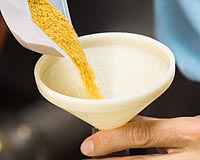 |
Houston TX (SPX) Jul 29, 2009 Much like humans, materials are capable of some pretty remarkable things when they're placed under pressure. In fact, under the right conditions, materials can even produce electricity. Driven by the vision of our society one day being basically self-propelled, a team of University of Houston scientists has set out to both amplify and provoke that potential in materials known as piezoelectrics, which naturally produce electricity when literally subjected to strain. The goal is to use piezoelectrics to create nanodevices that can power electronics, such as cell phones, MP3 players and even biomedical implants. "Nanodevices using piezoelectric materials will be light, environmentally friendly and draw on inexhaustible energy supplies," says associate professor Pradeep Sharma, one of the creative minds at the Cullen College of Engineering running two projects on piezoelectrics. "Imagine a sensor on the wing of a plane or a satellite. Do we really want to change its battery every time its power source gets exhausted? Hard-to-access devices could be self-powered." Piezoelectric materials convert mechanical energy into electrical energy, Sharma explains. "Indeed, gas lighters used in most homes are based on this," he says. "These future piezoelectric nanodevices will also generate an electrical current in response to mechanical stimuli. Then, the energy will be stored in batteries or, even better, in nanocapacitors for use when needed." Although piezoelectrics have been used for many years, Sharma's team is exploring new possibilities by beefing up the effect in natural piezoelectrics. Doing so requires understanding the phenomenon that spurs piezoelectricity, known as "flexoelectricity." "Flexoelectricity, at the nanoscale, allows you to coax ordinary material to behave like a piezoelectric one. Perhaps more importantly, this phenomenon exists in materials that are already piezoelectric. You can make the effect even larger," Sharma says. For example, the piezoelectricity in barium titanate can be increased by 300 percent when the material is reduced to a 2-nanometer-beam and pressure is applied. "Thus, you'll take an ordinary piezoelectric material and really give it some juice," he says. Sharma underscores the flexoelectric effect is a function of size - and the smaller the better, at least for generating piezoelectric power. Materials with nanoscale features - such as nanoscale thin plates stacked on each other or materials with particles or holes the size of a few nanometers - exhibit a much larger flexoelectric effect, he says. Ramanan Krishnamoorti, chairman of the department of chemical and biomolecular engineering, is working with Sharma to embed classes of nanostructures in polymers to create unusual types of piezoelectrics. Meanwhile, Sharma and professor Ken White recently reported that the electrical activity caused by flexoelectricity also affects a material's resiliency. They tested their theory - that the elasticity of a material would be quite altered by flexoelectricity-caused electrical activity - by poking the material with a sophisticated needle. "We basically predicted that when you poke it, because of this electrical activity, depending upon how big a crater you create, your elastic behavior will change. It's not supposed to. Ordinarily, whether you make a big crater or small crater, if you calculate how stiff it is or soft it is, it'll give you the same answer - a constant," Sharma says. White and Sharma conducted several experiments on single crystals of materials. "By monitoring the stiffness of the material as the crater became larger and larger," White says, "we discovered a change in elasticity relative to size, which could only be explained by flexoelectric effect." Though a fair amount of research on piezoelectrics has been done, White says, the fabrication of piezoelectric nanostructures remains challenging. The amount of power that can be harvested is still too low to actually power wearable devices, he says, unless efficient electric storage solutions, like nanocapacitors, also are conceived. Sharma says he would like to see wasted energy be harvested from a variety of sources. "In principle, any human activities - for example, walking, jumping, swimming - will produce a certain amount of energy," he says, and could be made into electricity by piezoelectric nanostructures in shoes or in backpacks. White says it's a matter of controlling materials' structures to the point at which considerably more power can be harvested from common activities. "An enormous benefit can be expected - in everything from soldiers in the field, to police on the street, to air and ground vehicles - in the form of locally powered devices," White explains. Sharma says the environment contains plenty of waste energy that can be harnessed into useful energy to make ours a "self-powered autonomous society." "Recent technological advances and breakthroughs play an important role toward achieving that goal, but we need to be patient," he says. "Quantum mechanics, the basis of modern electronics, was 'discovered' in the early 1900s. Think how long it has taken for us to exploit that." Share This Article With Planet Earth
Related Links University of Houston Powering The World in the 21st Century at Energy-Daily.com
 New Method Uses Electrolyzed Water For More Efficient Fuel Production
New Method Uses Electrolyzed Water For More Efficient Fuel ProductionUrbana IL (SPX) Jul 29, 2009 Using electrolyzed water rather than harsh chemicals could be a more effective and environmentally friendly method in the pretreatment of ethanol waste products to produce an acetone-butanol-ethanol fuel mix, according to research conducted at the University of Illinois. When ethanol is produced, distiller's dried grain with solubles (DDGS) is a waste product. The DDGS is primarily used as ... read more |
|
| The content herein, unless otherwise known to be public domain, are Copyright 1995-2009 - SpaceDaily. AFP and UPI Wire Stories are copyright Agence France-Presse and United Press International. ESA Portal Reports are copyright European Space Agency. All NASA sourced material is public domain. Additional copyrights may apply in whole or part to other bona fide parties. Advertising does not imply endorsement,agreement or approval of any opinions, statements or information provided by SpaceDaily on any Web page published or hosted by SpaceDaily. Privacy Statement |